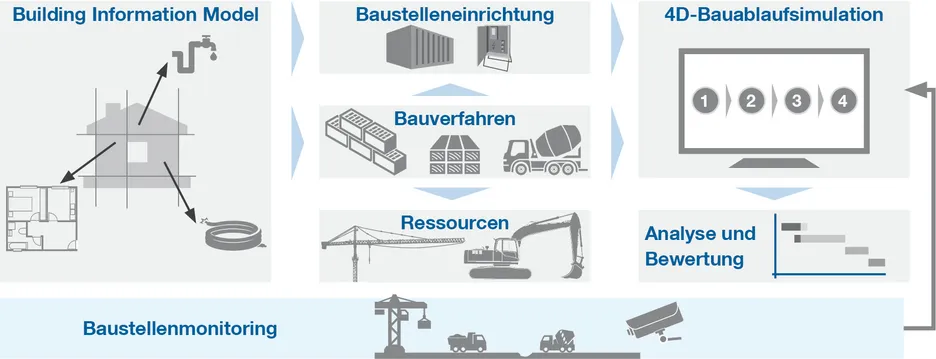BIM-based planning, simulation und monitoring of construction sites
| Lead | André Borrmann, Katrin Jahr |
| Ph.D. students | Felix Eickeler, Paul Häringer, Katrin Jahr |
| Funding | Bayerische Forschungsstiftung |
| Research partner | Lehrstuhl Fördertechnik Materialfluss Logistik (fml) |
| Industry partners | Bauer Spezialtiefbau GmbH, Deutsche Doka Schalungstechnik GmbH, Hilti AG, Knauf Gips KG, Max Bögl Bauservice GmbH & Co. KG, Nemetschek Allplan Systems GmbH, Obermeyer Planen + Beraten GmbH, Peri AG, PPI Informatik - Dr. Prautsch & Partner, Siemens Industry Software GmbH & Co. KG, SSF Ingenieure GmbH, think project! GmbH |
| Related projects | ForBAU, FAUST |
Description
The BIMsite project is focused on the transition from construction planning to construction process. Until recently, building layouts and construction drawings have been designed and delivered in 2D, leading to problems and delays on the construction site due to insufficient depth of planning. Building Information Modeling (BIM), the digital representation of physical and functional characteristics of a building, has been introduced into the field of civil engineering to improve planning efficiency and planning quality. BIM facilitates and accelerates the planning process by the use of semantic construction components and continuous data exchange. However, concerning the selection of construction methods on one hand and planning of construction work and construction schedules on the other hand, most engineers still use manual methods and rely on experience. Up to now, the development of a representation of the construction process in BIM is still in an early phase, giving away the opportunity to optimize the planning process towards time efficiency, robustness, as well as health and safety concerns.
The BIMsite project is dedicated to the question of how digital building models can be used for relevant questions in work preparation and during construction. On the one hand, it is to be examined which requirements building models must fulfil with regard to information content and level of detail so that a direct further use for the corresponding project phases is possible. Building on this, model-based methods of construction site simulation will be developed in a further focal point, which will make it possible to make statements about the project-critical target variables of productivity and safety. For the validation of the prognosis models, site monitoring procedures are to be used, which in addition enable dynamic adjustments and possible rescheduling during construction with little effort.
